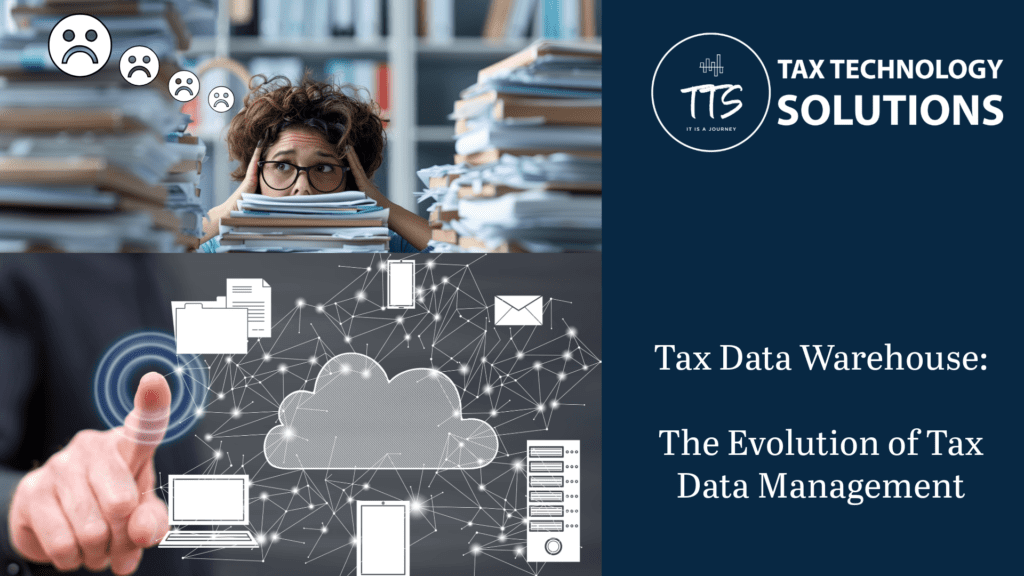
The Evolution of Tax Data Management: From Fragmented Excel Workbooks to Unified Data Warehouses
Tax professionals often find themselves juggling multiple responsibilities, from regulatory compliance to financial reporting. While Excel has long been a staple tool for tax calculations and reporting, its fragmented structure and use presents significant limitations. Repeated extract, transform, and load (ETL) processes across various Excel workbooks can lead to inefficiencies, inaccuracies, and wasted time. Enter the tax data warehouse—a robust, centralized solution that transforms how tax data is managed, calculated, and reported. This article delves into the advantages of a tax data warehouse compared to the traditional approach of fragmented Excel workbooks.
Efficiency and Time Savings
One of the key advantages of a tax data warehouse is its ability to streamline processes and save time. In the traditional Excel approach, the same data often needs to be repeatedly transformed to suit different calculations and reports. Tax professionals might copy and paste data across multiple workbooks, build custom formulas, or manually clean datasets—all of which are prone to errors and consume valuable time.
A tax data warehouse eliminates the need for repetitive ETL processes. With all tax data centralized in a single repository, calculations and reporting can be automated and accessed with ease. Predefined rules and queries allow tax professionals to retrieve the exact data they need without extensive manual intervention. This efficiency frees up time for higher-value tasks, such as tax planning or strategizing.
Accuracy and Reduced Errors
Manual processes in Excel introduce the risk of human error, whether through incorrect formulas, accidental overwrites, or outdated versions of workbooks. Errors in tax data can have serious consequences, including compliance issues, penalties, and financial inaccuracies.
Tax data warehouses address this challenge by creating a single source of truth. Data is stored in its raw form and transformed using standardized, automated processes. Built-in validation mechanisms ensure that errors are identified and corrected at the source, reducing the likelihood of mistakes downstream. As a result, businesses can trust the accuracy of their tax calculations and reports, fostering confidence in decision-making.
Scalability and Flexibility
As organizations grow, their tax data becomes more complex, often spanning multiple jurisdictions, entities, and reporting requirements. Excel’s fragmented structure struggles to keep up with this complexity, especially when data volumes surge. Tax professionals may find themselves overwhelmed by hundreds of workbooks, each catering to different scenarios.
Tax data warehouses are built to scale. They can accommodate large volumes of data from diverse sources, whether it’s transactional data, regulatory filings, or financial statements. Moreover, tax data warehouses offer flexibility in managing varied reporting requirements, enabling organizations to adapt to changes in tax laws or business operations with minimal effort.
Integration Across Departments
Tax data doesn’t exist in isolation—it often intersects with accounting, finance, and legal functions. Fragmented Excel workbooks can create silos, with each department managing its own set of data, leading to inconsistencies and duplication.
A tax data warehouse integrates seamlessly with other enterprise systems, such as ERP (Enterprise Resource Planning) platforms, analytics tools such as Alteryx, and all tax applications. This integration ensures that tax professionals have access to the latest, most accurate data from across the organization. Collaborative workflows are enhanced, and interdepartmental communication becomes more efficient, resulting in cohesive reporting and analysis.
Enhanced Reporting and Analytics
Tax reporting isn’t just about compliance; it’s also a valuable tool for gaining insights into a company’s financial health and identifying opportunities for optimization. Traditional Excel workbooks lack the advanced analytical capabilities needed to extract meaningful insights from tax data.
Tax data warehouses, on the other hand, are designed for advanced analytics. With powerful querying tools, dynamic dashboards, and the capability to seamlessly connect with other visualization tools like Alteryx and Tableau, tax professionals can uncover trends, assess risks, and evaluate scenarios more effectively. Frequently used reports can be generated in real time, tailored to specific audiences, and updated automatically, eliminating the need for manual report generation.
Improved Security and Governance
Tax data is sensitive and must be protected from unauthorized access, breaches, and misuse. Excel workbooks often lack robust security features, relying on password protection or shared drives, which may not be sufficient.
Tax data warehouses offer enterprise-grade security and governance measures. Role-based access control ensures that only authorized personnel can view or edit data. Audit trails track changes and provide accountability, while encryption safeguards sensitive information. These features help organizations meet regulatory requirements and reduce the risk of data breaches.
Cost-Effectiveness
While transitioning from Excel to a tax data warehouse requires an initial investment, the long-term cost benefits are substantial. Excel’s fragmented nature often leads to duplicated efforts, wasted resources, and inefficiencies. Tax data warehouses, with their automation and scalability, reduce operational costs and maximize productivity.
Additionally, tax data warehouses enable proactive tax data management, helping organizations identify opportunities to optimize tax positions and minimize liabilities. These strategic advantages contribute to overall financial health and sustainability.
Conclusion
The traditional use of fragmented Excel workbooks has served tax professionals for decades, but it comes with inherent limitations. Repeated ETL processes, inefficiencies, and risks of errors highlight the need for a more robust solution. Tax data warehouses offer a transformative approach, centralizing data, enhancing accuracy, and providing scalability, integration, and advanced analytics.
As businesses face increasing complexity in tax management and reporting, the shift to tax data warehouses is not just beneficial—it’s essential. By embracing this modern solution, tax professionals can focus on strategic decision-making and drive value across the organization, leaving behind the constraints of Excel’s fragmented structure.
Tax Technology Solutions is pleased to offer deeply discounted introductory development rates to any tax department interested in evaluating the benefits of a tax data warehouse with their own data. Please contact us for details at [email protected].